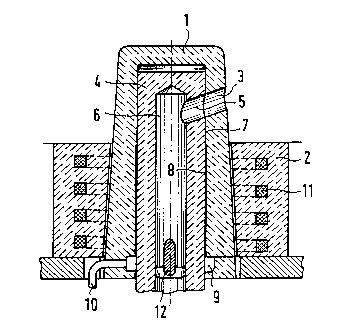Some of the information on this Web page has been provided by external sources. The Government of Canada is not responsible for the accuracy, reliability or currency of the information supplied by external sources. Users wishing to rely upon this information should consult directly with the source of the information. Content provided by external sources is not subject to official languages, privacy and accessibility requirements.
Any discrepancies in the text and image of the Claims and Abstract are due to differing posting times. Text of the Claims and Abstract are posted:
| (12) Patent Application: | (11) CA 2182606 |
|---|---|
| (54) English Title: | CONTROL AND CLOSURE DEVICE FOR A METALLURGICAL VESSEL |
| (54) French Title: | DISPOSITIF DE REGLAGE ET DE FERMETURE POUR UN RECIPIENT METALLURGIQUE |
| Status: | Deemed Abandoned and Beyond the Period of Reinstatement - Pending Response to Notice of Disregarded Communication |
| (51) International Patent Classification (IPC): |
|
|---|---|
| (72) Inventors : |
|
| (73) Owners : |
|
| (71) Applicants : |
|
| (74) Agent: | SMART & BIGGAR LP |
| (74) Associate agent: | |
| (45) Issued: | |
| (86) PCT Filing Date: | 1995-11-25 |
| (87) Open to Public Inspection: | 1996-07-11 |
| Availability of licence: | N/A |
| Dedicated to the Public: | N/A |
| (25) Language of filing: | English |
| Patent Cooperation Treaty (PCT): | Yes |
|---|---|
| (86) PCT Filing Number: | PCT/EP1995/004649 |
| (87) International Publication Number: | EP1995004649 |
| (85) National Entry: | 1996-08-01 |
| (30) Application Priority Data: | ||||||
|---|---|---|---|---|---|---|
|
A regulating and closing device for a metallurgical
vessel, having a rotor that is used to throttle or shut off
the flow of smelt which is supported so as to be rotatable
within a stator (1) that is arranged within a wall of the
vessel (2). This allows heating of the rotor (4) which is
surrounded by an inductor (11) or direct heating of the smelt
by coupling the smelt in the flow to the field of said
inductor (11) electromagnetically.
La présente invention concerne un dispositif de réglage et de fermeture d'un récipient métallurgique. Dans un stator (1) logé dans une paroi (2) du récipient, un rotor (4) est monté de façon à pouvoir tourner, pour réduire ou arrêter le passage de la coulée. Une possibilité de chauffage y est intégrée du fait que le rotor (4) est entouré d'un inducteur (11) au champ duquel la coulée, dans le conduit de passage (6), ou le rotor (4), peuvent être couplés électromagnétiquement.
Note: Claims are shown in the official language in which they were submitted.
Note: Descriptions are shown in the official language in which they were submitted.

2024-08-01:As part of the Next Generation Patents (NGP) transition, the Canadian Patents Database (CPD) now contains a more detailed Event History, which replicates the Event Log of our new back-office solution.
Please note that "Inactive:" events refers to events no longer in use in our new back-office solution.
For a clearer understanding of the status of the application/patent presented on this page, the site Disclaimer , as well as the definitions for Patent , Event History , Maintenance Fee and Payment History should be consulted.
| Description | Date |
|---|---|
| Time Limit for Reversal Expired | 2003-11-25 |
| Application Not Reinstated by Deadline | 2003-11-25 |
| Inactive: Status info is complete as of Log entry date | 2003-01-15 |
| Deemed Abandoned - Failure to Respond to Maintenance Fee Notice | 2002-11-25 |
| Inactive: Abandon-RFE+Late fee unpaid-Correspondence sent | 2002-11-25 |
| Application Published (Open to Public Inspection) | 1996-07-11 |
| Abandonment Date | Reason | Reinstatement Date |
|---|---|---|
| 2002-11-25 |
The last payment was received on 2001-10-30
Note : If the full payment has not been received on or before the date indicated, a further fee may be required which may be one of the following
Patent fees are adjusted on the 1st of January every year. The amounts above are the current amounts if received by December 31 of the current year.
Please refer to the CIPO
Patent Fees
web page to see all current fee amounts.
| Fee Type | Anniversary Year | Due Date | Paid Date |
|---|---|---|---|
| MF (application, 2nd anniv.) - standard | 02 | 1997-11-25 | 1997-10-30 |
| MF (application, 3rd anniv.) - standard | 03 | 1998-11-25 | 1998-10-27 |
| MF (application, 4th anniv.) - standard | 04 | 1999-11-25 | 1999-10-13 |
| MF (application, 5th anniv.) - standard | 05 | 2000-11-27 | 2000-10-20 |
| MF (application, 6th anniv.) - standard | 06 | 2001-11-26 | 2001-10-30 |
Note: Records showing the ownership history in alphabetical order.
| Current Owners on Record |
|---|
| DIDIER-WERKE AG |
| Past Owners on Record |
|---|
| BERNHARD SCHIEFER |
| RAIMUND BRUCKNER |
| RICK ARDELL |